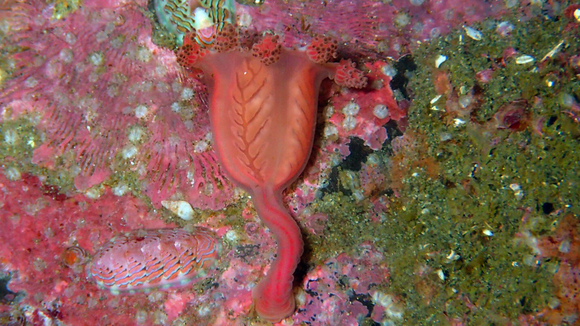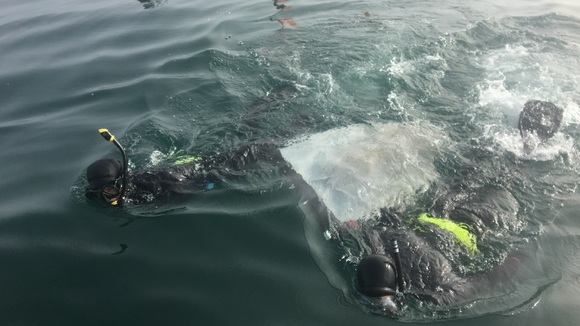HYPOXIA CAUGHT ON CAMERA
Click the video above to learn more about hypoxia off the Oregon coast.
Oregon State University's oceanic buoy, located in Cape Perpetua Marine Reserve, showed a drop in ocean oxygen levels in July. Around the same time, about 20 miles north, ODFW Marine Program crab biologists pulled up a research crab pot filled dead crabs. The crab pot was equipped with a video camera and the biologists caught an oceanic phenomenon on camera – crabs succumbing to a low oxygen, or hypoxic, event. Hypoxia is when oxygen levels in the water drop below the level that can be fatal to many marine organisms, and occurs periodically off the Oregon coast.
EVER SEEN A STALKED JELLY?
 A stalked jelly attached to a rock in Cascade Head Marine Reserve. This photo was taken by a scientific SCUBA diver during dive surveys 60 feet below the surface.
Have you ever seen a stalked jelly? This one was a first for us! Stalked jellies (or Stauromedusae) are a type of medusa jelly that, instead of floating freely around the ocean, attach to a rock or other hard substrate upside-down, using their stalk. The tentacles reach up into the water where they can sting small crustaceans and worms, then drag them into their mouths. They are related to the Cnidarians, which includes all other jellies, corals, and anemones.
This stalked jelly was seen in the Cascade Head Marine Reserve during SCUBA dive surveys in late August, at a depth of 60 feet. It is about one inch tall in the picture but can probably stretch its stalk and tentacles to double that.
WEEKLY SMURFING SERIES
 Researchers retrieving a SMURF off of Otter Rock Marine Reserve.
SMURFing
is still going strong, although our sampling season is winding down. Okay wait,
what’s a SMURF again? We’re not talking about the little, blue, hat-wearing
cartoons. SMURF stands for the “Standard Monitoring Unit for the Recruitment of
Fishes” and is a sampling tool we use to collect information on juvenile fish.
Tracking how many juveniles use nearshore habitats is helpful for understanding
any changes we see in adult populations in the future.
SMURF research is conducted weekly and be sure to check out our most recent posts on: predicting pulses, juvenile cabezon, the most common SMURF catches, and SMURF construction 101.
UPDATES FROM THE FIELD
 |
|
Two days of video lander and SCUBA surveys were conducted at Cascade Head Marine Reserve and associated comparison areas. |
 |
|
Conducted sea star wasting surveys at Otter Rock Marine Reserve and Cascade Head. |
 |
|
Conducted longline and hook-and-line combination surveys at Redfish Rocks Marine Reserve and associated comparison areas. Four additional days are scheduled for September. |
UPDATES FROM OUR COLLABORATORS
 |
|
Continuing through summer: Juvenile fish recruitment surveys (SMURFs) at Otter Rock and Redfish Rocks Marine Reserves (by OSU, ODFW Marine Reserves Program, and the Oregon Coast Aquarium). |
 |
|
pH sensors were deployed at all 5 Oregon Marine Reserves (Cape Falcon, Cascade Head, Otter Rock, Cape Perpetua and Redfish Rocks) by OSU researchers, with assistance from local community members. |
See More Oregon Marine Reserves News
|